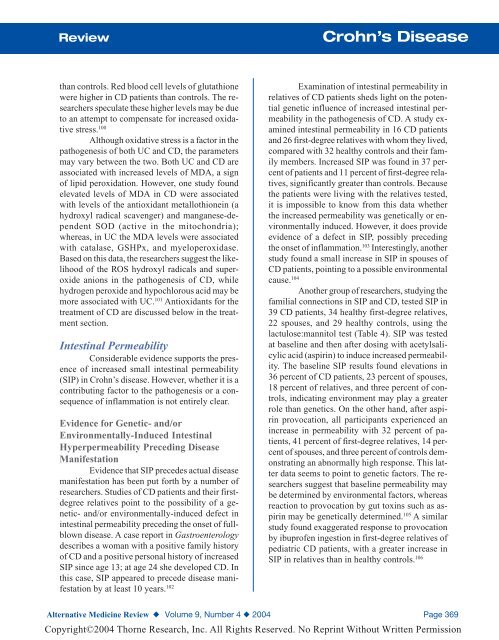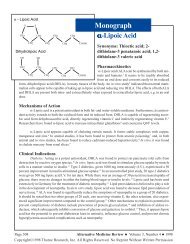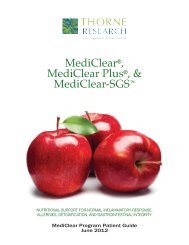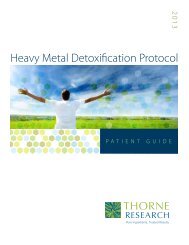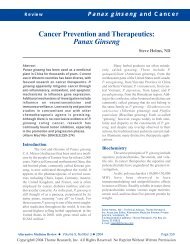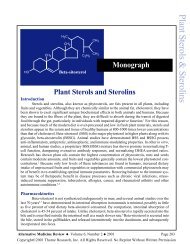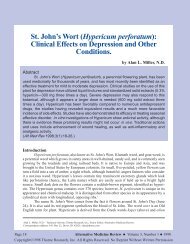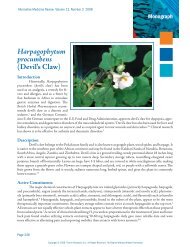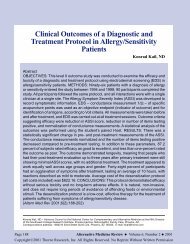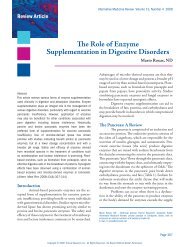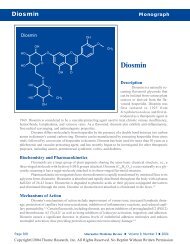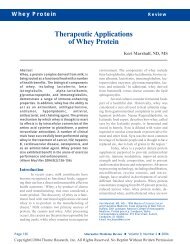Crohn's Disease - Thorne Research
Crohn's Disease - Thorne Research
Crohn's Disease - Thorne Research
Create successful ePaper yourself
Turn your PDF publications into a flip-book with our unique Google optimized e-Paper software.
ReviewCrohn’s <strong>Disease</strong>than controls. Red blood cell levels of glutathionewere higher in CD patients than controls. The researchersspeculate these higher levels may be dueto an attempt to compensate for increased oxidativestress. 100Although oxidative stress is a factor in thepathogenesis of both UC and CD, the parametersmay vary between the two. Both UC and CD areassociated with increased levels of MDA, a signof lipid peroxidation. However, one study foundelevated levels of MDA in CD were associatedwith levels of the antioxidant metallothionein (ahydroxyl radical scavenger) and manganese-dependentSOD (active in the mitochondria);whereas, in UC the MDA levels were associatedwith catalase, GSHPx, and myeloperoxidase.Based on this data, the researchers suggest the likelihoodof the ROS hydroxyl radicals and superoxideanions in the pathogenesis of CD, whilehydrogen peroxide and hypochlorous acid may bemore associated with UC. 101 Antioxidants for thetreatment of CD are discussed below in the treatmentsection.Intestinal PermeabilityConsiderable evidence supports the presenceof increased small intestinal permeability(SIP) in Crohn’s disease. However, whether it is acontributing factor to the pathogenesis or a consequenceof inflammation is not entirely clear.Evidence for Genetic- and/orEnvironmentally-Induced IntestinalHyperpermeability Preceding <strong>Disease</strong>ManifestationEvidence that SIP precedes actual diseasemanifestation has been put forth by a number ofresearchers. Studies of CD patients and their firstdegreerelatives point to the possibility of a genetic-and/or environmentally-induced defect inintestinal permeability preceding the onset of fullblowndisease. A case report in Gastroenterologydescribes a woman with a positive family historyof CD and a positive personal history of increasedSIP since age 13; at age 24 she developed CD. Inthis case, SIP appeared to precede disease manifestationby at least 10 years. 102Examination of intestinal permeability inrelatives of CD patients sheds light on the potentialgenetic influence of increased intestinal permeabilityin the pathogenesis of CD. A study examinedintestinal permeability in 16 CD patientsand 26 first-degree relatives with whom they lived,compared with 32 healthy controls and their familymembers. Increased SIP was found in 37 percentof patients and 11 percent of first-degree relatives,significantly greater than controls. Becausethe patients were living with the relatives tested,it is impossible to know from this data whetherthe increased permeability was genetically or environmentallyinduced. However, it does provideevidence of a defect in SIP, possibly precedingthe onset of inflammation. 103 Interestingly, anotherstudy found a small increase in SIP in spouses ofCD patients, pointing to a possible environmentalcause. 104 Another group of researchers, studying thefamilial connections in SIP and CD, tested SIP in39 CD patients, 34 healthy first-degree relatives,22 spouses, and 29 healthy controls, using thelactulose:mannitol test (Table 4). SIP was testedat baseline and then after dosing with acetylsalicylicacid (aspirin) to induce increased permeability.The baseline SIP results found elevations in36 percent of CD patients, 23 percent of spouses,18 percent of relatives, and three percent of controls,indicating environment may play a greaterrole than genetics. On the other hand, after aspirinprovocation, all participants experienced anincrease in permeability with 32 percent of patients,41 percent of first-degree relatives, 14 percentof spouses, and three percent of controls demonstratingan abnormally high response. This latterdata seems to point to genetic factors. The researcherssuggest that baseline permeability maybe determined by environmental factors, whereasreaction to provocation by gut toxins such as aspirinmay be genetically determined. 105 A similarstudy found exaggerated response to provocationby ibuprofen ingestion in first-degree relatives ofpediatric CD patients, with a greater increase inSIP in relatives than in healthy controls. 106Alternative Medicine Review ◆ Volume 9, Number 4 ◆ 2004 Page 369Copyright©2004 <strong>Thorne</strong> <strong>Research</strong>, Inc. All Rights Reserved. No Reprint Without Written Permission


